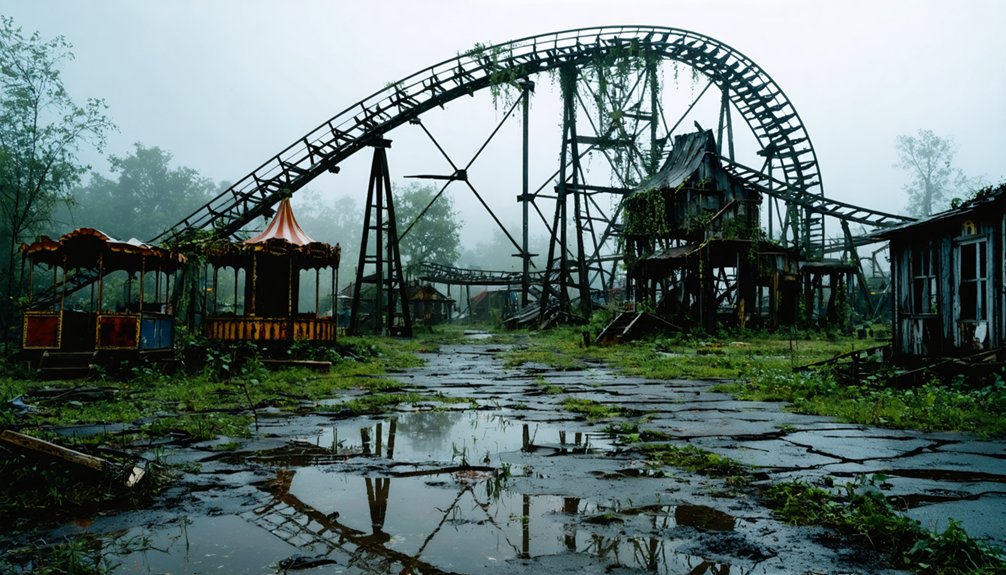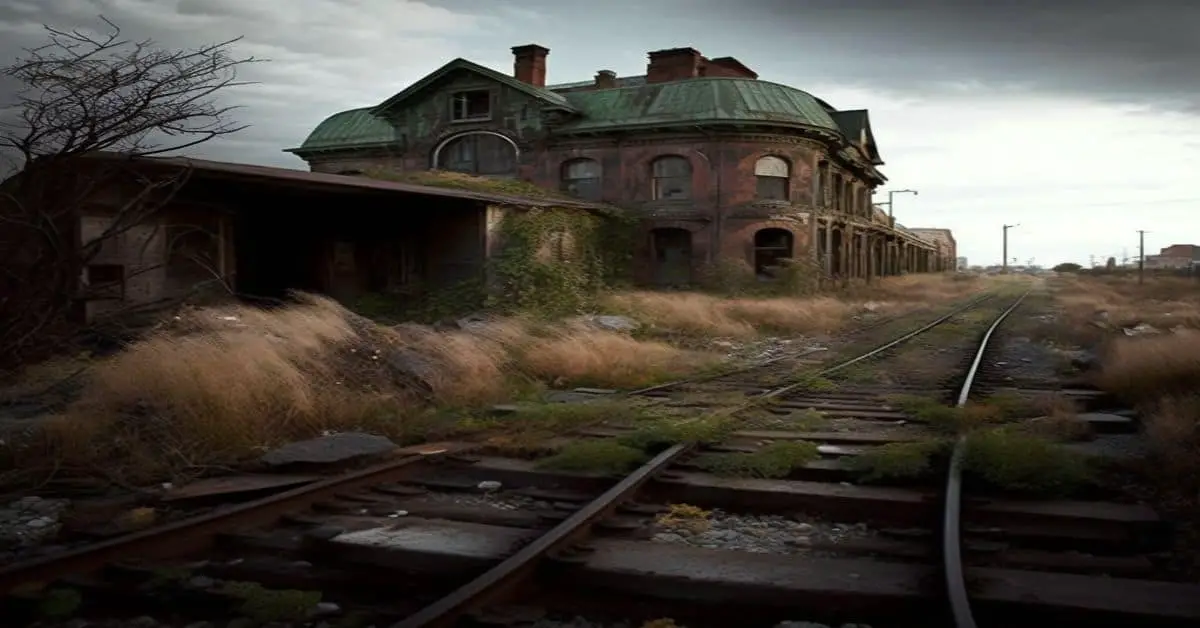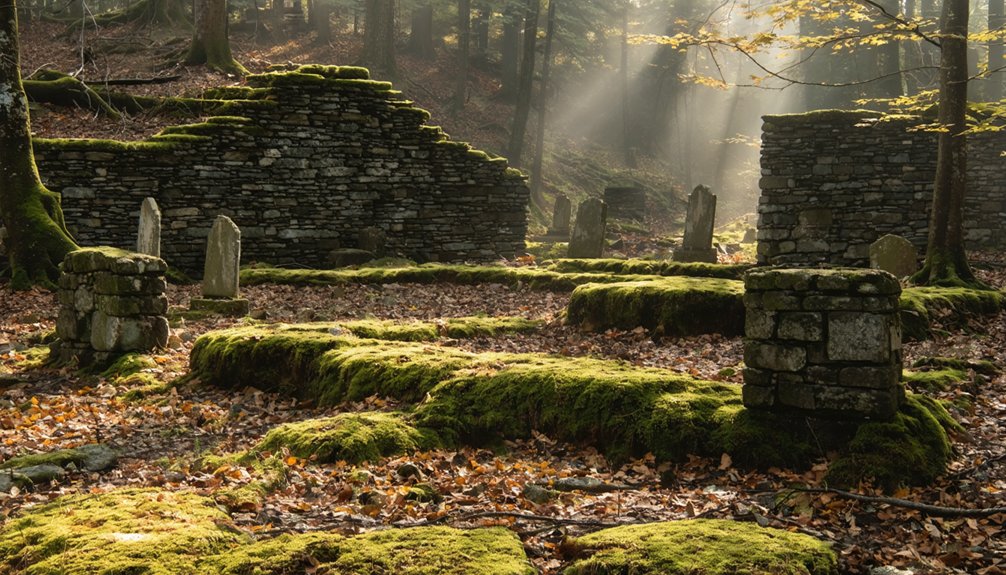You’ll discover Connecticut’s largest ghost town at Pleasure Beach, a former amusement park that operated from 1892 to 1959. The 37-acre island paradise once boasted New England’s largest dance pavilion, hosting jazz legends like Gene Krupa and Glenn Miller. After devastating fires in 1953 and 1973, plus a bridge collapse in 1996, nature reclaimed this abandoned wonderland. Today, while accessible by water taxi, the site preserves both its fascinating ruins and thriving wildlife sanctuary.
Key Takeaways
- Pleasure Beach became Connecticut’s largest ghost town after its 1959 closure following devastating fires and financial losses totaling $26,000 annually.
- The former amusement park operated from 1892 to 1959, featuring attractions like Steeplechase rides and New England’s largest ballroom.
- Access to the abandoned site was severely limited after a 1996 bridge fire, leaving structures to decay and nature to reclaim the land.
- The 77-acre barrier beach reopened in 2014 as a natural retreat, preserving both historical remnants and wildlife habitats.
- Archaeological evidence reveals layers of history, from Native American settlements to amusement park artifacts and maritime trading activities.
The Birth of a Seaside Paradise (1892-1904)
The late 19th century birth of Pleasure Beach began in 1889 when Bridgeport annexed a 37-acre island that would become one of Connecticut’s most beloved seaside destinations.
You’ll find the amusement park history started when Walter Nichols purchased a section of Long Beach from Stratford in 1887, later selling it to liquor dealers McMahon and Wren, who opened the park in 1892.
Steam ferries transported eager visitors across Lewis Gut to reach the entertainment destination.
When George C. Tilyou acquired the property in 1905, he transformed it into Steeplechase Island.
Glory Days: From Steeplechase to Dance Halls
During Pleasure Beach’s most vibrant era, its transformation into “Steeplechase Island” marked a significant turning point in 1905 when George C. Tilyou, the visionary behind Coney Island’s famous Steeplechase Park, purchased the property.
The site doubled as a Sunday-only ballpark for Bridgeport’s minor league baseball team from 1905 to 1912.
You’d have found yourself immersed in an ambitious recreation of Tilyou’s successful New York venture, as Steeplechase rides began dotting the landscape of this Connecticut shoreline destination.
While the available historical records about this period are limited, this era represented a pivotal moment in Pleasure Beach’s evolution.
A devastating fire in 1907 caused $60,000 in damages to the park’s facilities.
The incorporation of Tilyou’s proven entertainment formula brought new energy to the peninsula. Though his direct involvement lasted only until 1910, his influence set the stage for the later addition of dance hall performances that would become a defining feature of the park’s entertainment landscape.
Big Band Era and Entertainment Legacy
You’d have found yourself among thousands of young dancers at Pleasure Beach’s grand ballroom, where jazz legends like Gene Krupa, Glenn Miller, and Artie Shaw performed during the Big Band era’s peak from the 1930s to 1950s.
The maple dance pavilion, with its distinctive bell towers and glass sides, stood as New England’s largest ballroom, drawing crowds from across the northeast. The facility operated until it met a devastating end when fire destroyed it in 1973. Originally built as part of the Million Dollar Playground in 1892, it became a cornerstone of regional entertainment.
Your evening of swing would have unfolded on the pristine maple dance floor, where the sounds of America’s greatest jazz orchestras echoed until the pavilion’s tragic destruction by fire in 1973.
Jazz Legends Perform Here
Pleasure Beach’s maple-floored ballroom, New England’s largest dance venue of its time, became hallowed ground for jazz royalty during the Big Band era.
The skating rink and boardwalk added to the park’s diverse entertainment options, drawing visitors from across the region.
You would’ve witnessed some of America’s most influential musicians gracing the stage, creating an unforgettable jazz nostalgia that defined Connecticut’s cultural landscape.
The venue’s rich entertainment history included performances by Frank Sinatra himself, further cementing its status as a cultural cornerstone.
- Glenn Miller Orchestra drew thousands of young dancers to the glass-sided pavilion
- Gene Krupa’s legendary drum solos echoed through the bell towers
- Artie Shaw’s clarinet mastery captivated regional audiences
- Benny Goodman brought his swing genius to the maple dance floor
- Tommy Dorsey’s performances cemented the venue’s performance legacy
The ballroom’s architecture, with its innovative design and superior acoustics, helped establish Pleasure Beach as a premier destination for jazz enthusiasts, rivaling major East Coast entertainment venues until fire claimed the pavilion in 1973.
Dance Pavilion’s Golden Days
While jazz legends made the venue famous, the Dance Pavilion‘s true magic lay in its role as New England’s premier social destination from the 1920s through the 1950s.
You’d have found yourself gliding across the finest maple floor in the region, surrounded by the architectural beauty of glass-sided bell towers that defined the building’s distinctive silhouette.
As New England’s largest ballroom, the pavilion captured the essence of dance culture during the Big Band Era.
You could join thousands of other young people enthusiastic to experience the latest dance crazes, whether during community gatherings or grand celebrations.
Even after the 1953 park fire damaged nearby attractions, the Dance Pavilion remained a beacon of entertainment until flames claimed it in 1973, marking the end of an unforgettable era in Pleasure Beach’s history.
Today, only abandoned and vandalized remnants of this once-magnificent structure remain, hidden among overgrown brush and debris.
The Beginning of the End: 1953 Fire
You’ll find the 1953 fire at Pleasure Beach stands as the pivotal moment when this cherished amusement destination began its tragic descent, as faulty electrical wiring sparked flames that rapidly consumed the park’s wooden structures.
The financial toll exceeded $75,000 (over $800,000 today), destroying essential attractions like the fun house, penny arcade, and severely damaging the roller coaster that had drawn crowds for decades.
When firefighters couldn’t position their equipment across the narrow access bridge, their desperate climb up the roller coaster structure to battle the blaze symbolized both their dedication and the park’s inherent vulnerabilities that would ultimately lead to its demise.
The tragic fire proved devastating for the park’s future, as declining visitor numbers in subsequent years forced Pleasure Beach to permanently close its gates by 1959.
Devastating Flames Spread Fast
In 1953, faulty electrical wiring sparked a devastating blaze that would mark the beginning of Pleasure Beach’s demise. You wouldn’t believe how quickly the flames engulfed the park’s wooden structures, creating an unprecedented fire hazard.
The emergency response teams faced a nightmarish scenario – they couldn’t get their trucks across the narrow bridge to fight the inferno.
- Fun house and penny arcade were immediately consumed by flames
- Roller coaster and amusement house suffered severe damage
- Creosote-treated wood accelerated the fire’s spread
- Firefighters had to climb the coaster structure to battle flames
- Limited hose access under bridge substructures hampered efforts
The isolation of the island proved catastrophic, as the fire raged unchecked through multiple attractions.
With damages exceeding $75,000, this disaster struck a devastating blow to the park’s future.
Financial Losses Mount High
The 1953 fire dealt more than just physical damage to Pleasure Beach – it ignited a chain of financial catastrophes that would ultimately seal the park’s fate.
With damages exceeding $75,000, you’d find the park struggling against mounting financial difficulties that proved insurmountable.
The revenue decline had actually begun before the flames, but the fire accelerated the park’s downward spiral.
By the late 1950s, you could see the stark reality in the numbers – a staggering $26,000 annual deficit plagued operations.
Even when new owners took over in 1958, they couldn’t reverse the park’s fortunes.
The damaged bridge restricted bus access, further choking off visitor numbers.
Despite attempts to invest in new attractions, the combination of repair costs, limited accessibility, and dwindling attendance forced Pleasure Beach to close permanently in 1959.
End Of An Era
While faulty electrical wiring sparked the initial flames in 1953, few could have predicted how this fire would become Pleasure Beach’s death knell.
As the flames ravaged through beloved attractions, nostalgic memories of summer fun turned to ash. You’d soon witness the devastating community impact as this once-thriving destination spiraled into decline.
- Emergency crews couldn’t cross the narrow bridge with their hook and ladder trucks
- Fire damage exceeded $75,000, devastating for a 1950s attraction
- Key features like the roller coaster, fun house, and penny arcade were destroyed
- The park’s reopening couldn’t restore its former glory
- Visitor numbers plummeted as major attractions remained closed
Bridge to Nowhere: The 1996 Disaster
During January 1996, a devastating ice jam triggered the partial collapse of Harrisburg’s historic Walnut Street Bridge, marking one of Pennsylvania’s most significant bridge disasters.
The 1996 ice jam that devastated Harrisburg’s Walnut Street Bridge became a defining moment in Pennsylvania’s infrastructure history.
This event would later influence bridge safety protocols nationwide, as engineers and city planners learned valuable lessons about the destructive power of winter ice formations on aging infrastructure.
You’ll find similar challenges at Pleasure Beach’s infamous “Bridge to Nowhere,” where environmental forces have taken their toll.
Like the Walnut Street Bridge, this structure stands as a monument to how weather conditions can compromise even the most robust engineering.
The disaster response protocols developed after such incidents have shaped modern emergency planning, though they couldn’t prevent Pleasure Beach’s bridge from becoming a haunting reminder of nature’s power over human construction.
Tales of Captain Kidd’s Lost Treasure
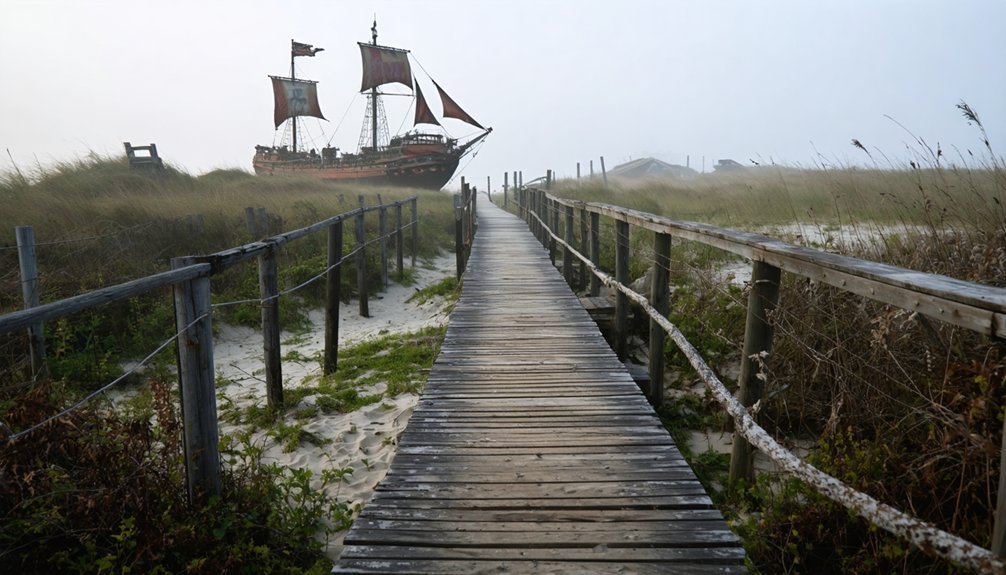
You’ll find remnants of colonial smuggling routes along Pleasure Beach’s shoreline where treasure hunters still search for Captain Kidd’s legendary buried gold.
Through the centuries, countless seekers have scoured these sandy shores, convinced that Kidd chose this secluded peninsula to hide his ill-gotten wealth.
In 1923, a group of spiritualists claimed they received otherworldly guidance about the treasure’s location, but their excavation efforts, like all others before and since, proved fruitless.
Hidden Colonial Smuggling Routes
Along Connecticut’s rugged southern coastline, Charles Island and Pleasure Beach concealed a complex network of colonial smuggling routes that defied British trade restrictions in the 17th and 18th centuries.
These strategic waterways became crucial arteries of colonial resistance, where merchants cleverly exploited the region’s natural geography to bypass imperial taxation.
- Saltwater marshes and secluded coves provided perfect cover for clandestine landings
- The island’s tombolo, accessible only at low tide, offered strategic advantages for quick escapes
- Local authorities often turned a blind eye to illicit trade activities
- Underground networks connected Connecticut to Long Island and Block Island
- Silver and gold moved freely through these secret maritime corridors
This intricate web of smuggling routes represented more than mere criminal enterprise—it embodied the colonists’ determination to maintain economic independence from British control.
Treasure Hunters Still Search
While colonial smugglers left their mark on Pleasure Beach’s history, an even more enticing legacy draws fortune seekers to these shores.
You’ll find Captain Kidd’s treasure legends alive and well here, where a massive 25-foot statue once stood in 1894 celebrating the infamous pirate’s connection to these sands.
The allure of Kidd’s alleged 70,000-pound sterling fortune – in gold, gems, silk, and opium – continues to captivate modern-day explorers.
You’re walking the same shores where islanders claimed to witness Kidd himself burying iron chests.
Despite centuries of searching and the supposed curse he placed on the treasure, determined hunters still probe the beach’s mysterious tunnels and sandy expanses.
While old coins occasionally surface, Kidd’s legendary riches remain tantalizingly out of reach, protected by both practical and supernatural barriers.
Spiritualists’ Failed Discovery Attempt
In the 1850s, a determined group of spiritualists commenced on what would become one of Pleasure Beach’s most peculiar treasure hunts.
Led by a medium who claimed supernatural insight into Captain Kidd’s buried riches, they followed strict spiritualism practices during their ambitious excavation.
- You’d have found them digging in complete silence, following the medium’s insistence that whispers were the only acceptable form of communication.
- Their dedication to the mystical quest lasted a full month.
- The treasure myths seemed within reach until a digger’s injured toe led to a loud curse.
- Their silence-bound excavation came to an abrupt end after the outburst.
- Like many spiritualist-led ventures of the era, this attempt to bridge the physical and spiritual worlds proved unsuccessful.
The failed quest stands as a reflection of the era’s fascinating blend of mysticism and treasure hunting fervor.
Life After Abandonment: Nature Reclaims
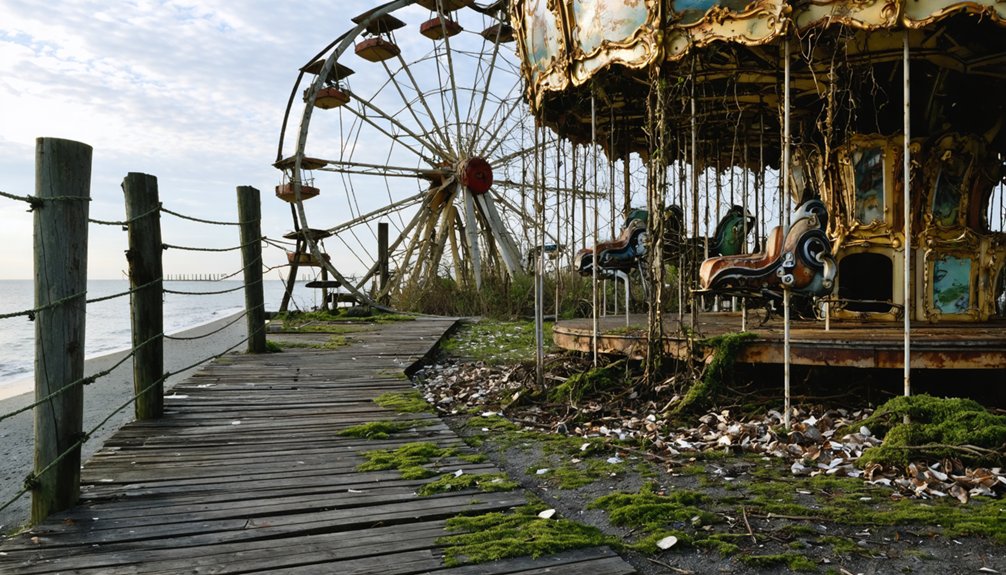
Since the devastating bridge fire of 1996, nature has steadily reclaimed Pleasure Beach’s abandoned structures and landscapes.
You’ll find buildings draped in wild vegetation and former entertainment spaces transformed into thriving habitats for endangered species. The area’s wildlife conservation success story includes the return of piping plovers and the flourishing of native plants like prickly pear cactus.
The ecological restoration reached a turning point in 2014 when officials reopened Pleasure Beach as a natural retreat.
You can now explore this transformed space where nature’s resilience shines through decades of abandonment. While the old amusement park’s remnants still whisper tales of the past, you’ll discover a new kind of attraction – one where wildlife thrives and natural beauty prevails over the former entertainment destination.
Hidden Archaeological Discoveries
Beneath Pleasure Beach’s weathered surface lies a rich archaeological tapestry dating back centuries before European settlement. The area’s cultural heritage reveals itself through significant discoveries that showcase its complex history.
- Ancient indigenous burial grounds and village remnants predating European colonization
- Evidence of Captain Kidd’s alleged treasure sites, leading to numerous excavations since the 1850s
- Underground tunnels and warehouses used for maritime smuggling operations
- Scattered coins and artifacts from both maritime trade and the area’s amusement park era
- Structural remains of early 20th-century entertainment facilities, including pavilion foundations
You’ll find archaeological significance in every layer of Pleasure Beach’s past, from Native American settlements to pirate legends and entertainment history.
These discoveries continue to emerge, painting a vivid picture of human activity spanning centuries along Connecticut’s coast.
Wildlife Sanctuary and Natural Haven
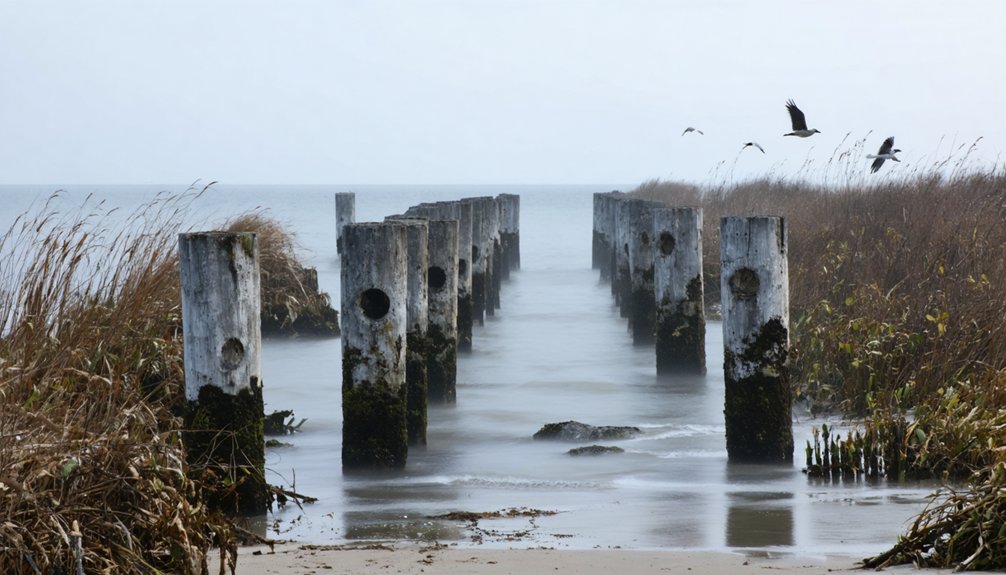
While archaeological discoveries reveal Pleasure Beach’s human history, the area’s true treasure lies in its thriving natural sanctuary.
Beyond the ancient artifacts and human footprints lies a vibrant refuge where nature takes center stage.
You’ll find 77 acres of pristine barrier beach, representing one-fifth of Connecticut’s undeveloped coastline, where wildlife conservation efforts have created a haven for hundreds of bird species.
As part of the Stratford Great Meadows Important Bird Area, you’ll witness remarkable ecological restoration in action.
The protected salt marshes filter Long Island Sound’s waters while providing essential nursery grounds for marine life.
You can spot ospreys nesting on purpose-built towers, observe threatened plovers and terns along the shore, and watch migratory birds like Least Sandpipers stopping over on their journey to Canadian breeding grounds.
The WildLife Guards program, established in 2012, guarantees this natural paradise continues to thrive.
Modern-Day Access and Preservation
After nearly two decades of abandonment following the 1996 bridge fire, Pleasure Beach reopened to the public in June 2014 with a fresh vision focused on natural preservation rather than commercial entertainment.
Today’s modern accessibility offers you a chance to explore this unique coastal treasure, where environmental restoration has transformed the former amusement park into a serene public retreat.
You’ll find that most remnants of the old attractions have been cleared away, preserving the area’s natural beauty while honoring its historical significance.
- Water taxi service provides convenient access to the barrier beach
- Historical artifacts are preserved at the Bridgeport History Center
- Natural environment has been restored and protected
- Original amusement infrastructure has been removed for safety
- Site maintains its status as Connecticut’s largest ghost town
Frequently Asked Questions
Were There Any Reported Ghost Sightings During the Abandoned Years?
Peculiarly, you won’t find proven ghostly apparitions during those desolate days. While urban explorers dubbed it among haunted attractions, no credible supernatural sightings were ever officially documented in the area.
What Happened to the Amusement Park Employees After Its Closure?
You’ll find many employees likely shifted to Bridgeport’s industrial jobs or other regional amusement venues, while some found limited work at the Polka Dot Playhouse. Most had to seek entirely new employment opportunities.
Did Any Movies or TV Shows Film at Pleasure Beach?
You won’t find major films shot at Pleasure Beach, though local documentaries have captured its abandoned state. The site’s isolation and difficult access have limited its use as a filming location.
How Much Did Admission Cost During the Park’s Peak Years?
You won’t find exact admission prices during the peak years on record, though comparable parks of that era typically charged modest fees plus additional costs for rides and ferry transport.
Were There Any Documented Drownings or Accidents at Pleasure Beach?
You won’t find documented drowning incidents specifically at Pleasure Beach in historical records, though Connecticut’s beaches saw regular accidents. The park likely had basic safety measures, but detailed records aren’t preserved.
References
- https://www.abandonedspaces.com/towns/pleasure-beach-connecticuts-largest-ghost-town-brought-back-to-life-after-almost-two-decades-of-abandonment.html
- https://www.abandonedamerica.us/pleasure-and-long-beach
- https://www.connecticutvisitorguide.com/nature/beaches/pleasure-beach/
- https://bportlibrary.org/hc/entertainment/the-legend-of-pleasure-beach/
- https://www.damnedct.com/long-beach-west-stratford-and-pleasure-beach-bridgeport/
- http://oldpleasurebeachct.com
- https://en.wikipedia.org/wiki/Pleasure_Beach
- https://i95rock.com/the-abandoned-ruins-and-the-story-behind-the-comeback-of-connecticuts-pleasure-beach/
- https://www.atlasobscura.com/places/pleasure-beach
- https://theclio.com/entry/21684
